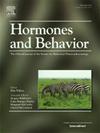母性照顾的窝内差异是雌性Long-Evans大鼠后代行为和单胺神经化学个体差异的关键因素
IF 2.4
3区 医学
Q2 BEHAVIORAL SCIENCES
引用次数: 0
摘要
母鼠提供的照顾对幼鼠的生存和茁壮成长至关重要。母性照顾在不同胎仔之间自然是不同的,包括在遗传亲缘关系密切的动物之间。即使在共同抚养的后代中,行为也存在显著差异。我们的实验室和其他实验室已经记录了稳定的、自然发生的个体差异,这些差异至少在出生后的头十天内持续存在。在本研究中,我们假设,在龙伊文斯大鼠的后代行为和神经化学变异中,母性照顾的窝内变化是一个重要的来源。我们分析了与母亲照顾行为、后代焦虑和社交行为以及后代成为母亲后特定大脑区域的神经递质水平相关的测量。对于统计建模,我们使用变异系数(CV)来标准化和直接比较一系列行为和神经生理结果的凋落物之间和凋落物内的变异。分析的几个变量表明,窝内CVs大于窝间CVs,特别是后代行为和单胺类多巴胺、血清素及其主要代谢物DOPAC(3,4-二羟基苯基乙酸)和5-HIAA(5-羟基吲哚乙酸)在伏隔核、腹侧被盖区、内侧视前区、海马和前额皮质中的水平。我们的研究结果表明,产妇护理的窝内变化在行为和生理结果中起着重要作用。本研究提供了一个方法上的进步,通过证明在母系、行为和神经化学领域,窝内变异性往往超过窝间变异性,挑战了使用窝友控制的实验设计中的一个关键假设。本文章由计算机程序翻译,如有差异,请以英文原文为准。
Within-litter variation in maternal care is a key contributor to individual differences in offspring behavior and monoamine neurochemistry in female Long–Evans rats
The care that a mother rat provides is essential for the ability of her pups to survive and thrive. Maternal care naturally varies between litters, including among animals with close genetic relatedness. There are also significant differences in behavior even among offspring reared together. Our lab and others have documented stable, naturally occurring individual differences in maternal care received by individual pups within the litter that persist throughout at least the first ten days of postnatal life. In this study, we hypothesized that within-litter variation in maternal care received constitutes a significant source of variation in offspring behavior and neurochemistry in Long-Evans rats. We analyzed measures related to maternal care behavior, offspring anxiety-like and social behaviors, and neurotransmitter levels in specific brain regions after the offspring became mothers themselves. For statistical modeling, we used the coefficient of variation (CV) to standardize and directly compare between- and within-litter variation across a range of behavioral and neurophysiological outcomes. Several variables analyzed showed greater within-litter CVs than between-litter CVs, especially for offspring behavior and levels of the monoamines dopamine, serotonin, and their primary metabolites DOPAC (3,4-dihydroxyphenylacetic acid) and 5-HIAA (5-hydroxyindoleacetic acid) in the nucleus accumbens, ventral tegmental area, medial preoptic area, hippocampus, and prefrontal cortex. Our findings suggest that within-litter variation in maternal care plays a prominent role in behavioral and physiological outcomes. This study provides a methodological advance by demonstrating that within-litter variability often exceeds between-litter variability across maternal, behavioral, and neurochemical domains, challenging a key assumption in experimental designs using littermate controls.
求助全文
通过发布文献求助,成功后即可免费获取论文全文。
去求助
来源期刊

Hormones and Behavior
医学-行为科学
CiteScore
6.70
自引率
8.60%
发文量
139
审稿时长
91 days
期刊介绍:
Hormones and Behavior publishes original research articles, reviews and special issues concerning hormone-brain-behavior relationships, broadly defined. The journal''s scope ranges from laboratory and field studies concerning neuroendocrine as well as endocrine mechanisms controlling the development or adult expression of behavior to studies concerning the environmental control and evolutionary significance of hormone-behavior relationships. The journal welcomes studies conducted on species ranging from invertebrates to mammals, including humans.
 求助内容:
求助内容: 应助结果提醒方式:
应助结果提醒方式:


